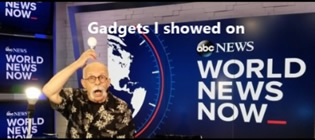One brand of TV in the late 1950’s came with something no other TV offered. It’s own “halo”!
 February 11, 2010
February 11, 2010  Post a Comment
Post a Comment Back to Dick’s Gadget Warehouse Friday, February 12th, Netcast 1025
 When I was a kid it was widely believed, at least by our parents, that you needed to have some sort of light on in the room where you watched TV. If you didn’t, because of the stark contract between the brightness of TV picture and the darkness of the room, you would ruin you eyesight. At least that was the theory. But in the late 1950’s Sylvania solved that “problem” with something they called "Halo Light". The black & white TV sets they sold had a fluorescent light behind a translucent frame that surrounded the picture tube. So the Halo Light took the place of having to have a lamp on in the room. Halo Light could be turned on and off, but why would you shut it off? You would “show it off”, not shut it off! Halo light made claims like: "You'll see the difference instantly! Pictures framed in exciting HALOLIGHT appear larger, sharper and clearer!" Actually, I thought Halo light was really neat. Sure it was a gimmick, but even as a kid, I liked things like that. It was big for several years and then disappeared. But in 2004 Philips came up with "Ambilight", which was a similar idea. It worked differently; by projecting a glow of light on the wall directly behind the screen. Over the years Philips enhanced Ambilight so you could control the color, or have the TV project a color on the wall that matched the primary color on the screen at that moment. Ambilight is still available on the newest Philips flat screen TV’s:
When I was a kid it was widely believed, at least by our parents, that you needed to have some sort of light on in the room where you watched TV. If you didn’t, because of the stark contract between the brightness of TV picture and the darkness of the room, you would ruin you eyesight. At least that was the theory. But in the late 1950’s Sylvania solved that “problem” with something they called "Halo Light". The black & white TV sets they sold had a fluorescent light behind a translucent frame that surrounded the picture tube. So the Halo Light took the place of having to have a lamp on in the room. Halo Light could be turned on and off, but why would you shut it off? You would “show it off”, not shut it off! Halo light made claims like: "You'll see the difference instantly! Pictures framed in exciting HALOLIGHT appear larger, sharper and clearer!" Actually, I thought Halo light was really neat. Sure it was a gimmick, but even as a kid, I liked things like that. It was big for several years and then disappeared. But in 2004 Philips came up with "Ambilight", which was a similar idea. It worked differently; by projecting a glow of light on the wall directly behind the screen. Over the years Philips enhanced Ambilight so you could control the color, or have the TV project a color on the wall that matched the primary color on the screen at that moment. Ambilight is still available on the newest Philips flat screen TV’s:
http://www.consumer.philips.com/c/televisions/33092/cat/gb/
Hear this Netcast: www.twit.tv/dgw1025













Reader Comments